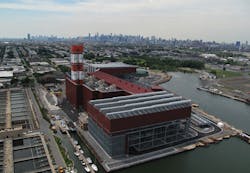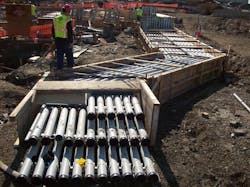East Coast Contractor Performs Design/Assist for 550MW New York Power Plant
Over the last 12 years, New York State has added almost 9,200MW of electric generation, according to “Power Trends 2012: State of the Grid,” a report published by the NYISO. It should hardly come as a surprise that more than 80% of this new generation is located in the Big Apple — America’s most populous city. To help power the densely inhabited metropolis, Astoria Energy, LLC recently constructed a 550MW natural gas combined-cycle power plant in the borough of Queens, N.Y. Operating adjacent to yet separately from the six-year-old Astoria Phase I power plant, the Astoria Phase II was a multi-million dollar undertaking that resulted in one of the state’s cleanest power plants.
“The Astoria Phase II can operate off of either natural gas or No. 2 fuel oil, and it contains the most up-to-date air pollution controls and monitoring systems,” says Tom Kregel, project executive for E-J Electric, the Long Island City, N.Y.-headquartered electrical contractor that supplied design/assist services for the project’s high- and low-voltage power systems. “By displacing several less-efficient local power plants, the Astoria Phase II owners expect to decrease nitrogen oxide air emissions by 1,222 tons per year and lower sulfur oxide emissions by 1,542 tons.”
To make the plant even more environmentally friendly, it employs an air-cooled condenser to eliminate the need to draw water from the nearby East River.
Despite the scope of the project, E-J Electric is no stranger to this type of work. The company constructed the $650 million Astoria Phase I plant in 2006 as well as the neighboring NYPA500 power plant in 2005.
Like Astoria Phase I, Phase II includes a steam turbine generator, two combustion turbines, and two heat recovery steam generators (HRSGs).
“Operations are run via a control room that we originally built during Phase I,” explains Brendon Bergin, senior project manager for E-J Electric. “During Phase II, we expanded and updated the control room, because it contains equipment for both sectors of the plant. Both phases contain a load-commutated inverter that ties the plants together. Each inverter is capable of starting the turbines, which are enclosed in a 97,000-sq-ft steel-framed structure, for Phase II as well as those located at Phase I.”
According to Kregel, the fast-track and tightly sited project, which broke ground in 2009, required his company to perform a large amount of preplanning, such as 3D modeling, along with prefabrication of some major equipment. For example, the HRSGs, air-cooled condenser, and pipe racks were assembled off-site and then transported by barge to Phase II once they were ready for installation.
“Needless to say, constructing a power plant on just 7 acres in the middle of one of the nation’s most densely inhabited neighborhoods presented some major challenges,” says Kregel. “We had very limited laydown area, which meant we had nowhere to store anything. This resulted in many just-in-time deliveries that were basically being installed as they were arriving.”
To keep the project on schedule, E-J Electric required two crews to work alternate 10-hr shifts.
“We basically ran the project 20 hours a day,” notes Bergin. “At peak, we had 250 electricians working on Phase II.”
Underground duct banks powering the main power distribution center.
The 345kV gas-insulated switchyard and control room had to be constructed on land located across from the Astoria plant that was formerly used for bulk oil storage.
“Unfortunately, the petroleum products stored there contaminated the soil, and it had to be remediated,” says Kregel. “The approximately 100 men working at the property received extensive health and safety training.”
In addition to the equipment previously mentioned, E-J Electric installed underground duct feeds, electrical switchgear, underground sets of 345kV solid dielectric cables, and a 345kV overhead transmission line.
“We also installed all the controls, instrumentation, and metering associated with the gas-insulated switchgear and switchyard power distribution equipment, along with the lighting, building management, security, fire alarm, and communication systems,” remarks Kregel.
By the project’s completion, the company had laid 90,000 ft of underground conduit, 10,000 ft of cable tray, 185,000 ft of aboveground conduit, 190,000 ft of power cable, 620,000 ft of control and instrumentation cable, 30,000 ft of medium-voltage cable, and 40,000 ft of grounding cable.
In spite of the compressed schedule and confined work area, E-J Electric completed its portion of the Astoria Phase II Project on schedule.
“The new power plant is a win-win for everyone involved,” Kregel says. “The client gets a state-of-the-art industrial facility, and the citizens of New York can breathe a little easier.”
About the Author
Stefanie Kure
Content Producer - EC&M
Stefanie Kure is the senior associate editor of EC&M magazine. She holds a Bachelor of Arts degree from the University of Kansas and has more than 20 years of experience in the B2B magazine industry. In addition to EC&M, Stefanie has worked on Transmission & Distribution World magazine, Broadcast Engineering magazine, and Power Electronics Technology magazine.


